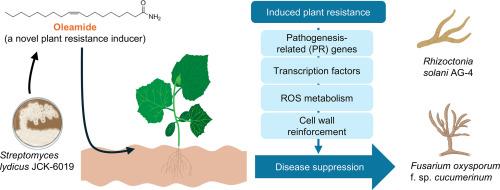lydicus链霉菌JCK-6019油酰胺诱导黄瓜对枯萎病和枯萎病的抗性
IF 4
1区 农林科学
Q2 BIOCHEMISTRY & MOLECULAR BIOLOGY
引用次数: 0
摘要
油酰胺(顺-9-十八烯酰胺)是一种从油酸中提取的初级脂肪酸酰胺,因其在哺乳动物系统中的神经和免疫调节作用而闻名。然而,其在植物免疫中的作用尚未被探索。本研究确定了油酰胺是lydicus链霉菌JCK-6019的主要生物活性代谢物,是一种新型的黄瓜植物抗性诱导剂(PRI)。虽然油酰胺在体外对黄瓜尖孢镰刀菌和黄瓜根丝核菌AG-4没有直接的抗真菌活性,但在体内实验显示出较强的抑制作用。在0.1 ng/mL的浓度下,油酰胺对枯萎病的防治效果为66.28%,与商业PRI Bion(69.77%)相当;在0.01 ng/mL的浓度下,油酰胺对枯萎病的防治效果为80%,而Bion则无效。生理实验结果显示,油酰胺减少了丙二醛的积累,同时增强了过氧化物酶和多酚氧化酶的活性,表明抗氧化防御被激活。基因表达分析进一步揭示了关键防御相关基因(PR1、PR2、PR4、WRKY30、WRKY67、ERF003、过氧化物酶和纤维素合成酶)的上调,这些基因参与水杨酸和花酸/乙烯信号转导、转录调控、活性氧代谢和细胞壁强化。综上所述,这些结果表明,油酰胺引发了黄瓜的防御反应,而不是作为一种真菌毒性化合物。据我们所知,这是首次报道证实油酰胺是一种有效防治黄瓜两种主要土传病害的PRI。其纳克级别的功效、无毒性质和激活植物免疫的能力突出了其作为可持续作物保护的合成杀菌剂的环保替代品的潜力。本文章由计算机程序翻译,如有差异,请以英文原文为准。

Induced resistance in cucumber by oleamide from Streptomyces lydicus JCK-6019 against cucumber Fusarium wilt and damping-off
Oleamide (cis-9-octadecenamide), a primary fatty acid amide derived from oleic acid, is well known in mammalian systems for its roles in neural and immune regulation. However, its function in plant immunity has remained unexplored. In this study, oleamide was identified as the major bioactive metabolite of Streptomyces lydicus JCK-6019 and was characterized as a novel plant resistance inducer (PRI) in cucumber. Although oleamide exhibited no direct antifungal activity against Fusarium oxysporum f. sp. cucumerinum and Rhizoctonia solani AG-4 in vitro, in vivo assays demonstrated strong disease suppression. Preventive application of oleamide achieved 66.28 % control of Fusarium wilt at 0.1 ng/mL, comparable to the commercial PRI Bion (69.77 %), and 80 % control of damping-off at 0.01 ng/mL, whereas Bion was ineffective. Physiological assays revealed that oleamide reduced malondialdehyde accumulation while enhancing peroxidase and polyphenol oxidase activities, indicating activation of antioxidant defense. Gene expression analysis further revealed upregulation of key defense-related genes (PR1, PR2, PR4, WRKY30, WRKY67, ERF003, peroxidase, and cellulose synthase), which are involved in salicylic acid and jasmonic acid/ethylene signaling, transcriptional regulation, reactive oxygen species metabolism, and cell wall strengthening. Collectively, these results indicate that oleamide primes cucumber defense responses rather than acting as a fungitoxic compound. To our knowledge, this is the first report identifying oleamide as a PRI effective against two major soil-borne cucumber diseases. Its nanogram-level efficacy, non-toxic nature, and capacity to activate plant immunity highlight its potential as an eco-friendly alternative to synthetic fungicides for sustainable crop protection.
求助全文
通过发布文献求助,成功后即可免费获取论文全文。
去求助
来源期刊
CiteScore
7.00
自引率
8.50%
发文量
238
审稿时长
4.2 months
期刊介绍:
Pesticide Biochemistry and Physiology publishes original scientific articles pertaining to the mode of action of plant protection agents such as insecticides, fungicides, herbicides, and similar compounds, including nonlethal pest control agents, biosynthesis of pheromones, hormones, and plant resistance agents. Manuscripts may include a biochemical, physiological, or molecular study for an understanding of comparative toxicology or selective toxicity of both target and nontarget organisms. Particular interest will be given to studies on the molecular biology of pest control, toxicology, and pesticide resistance.
Research Areas Emphasized Include the Biochemistry and Physiology of:
• Comparative toxicity
• Mode of action
• Pathophysiology
• Plant growth regulators
• Resistance
• Other effects of pesticides on both parasites and hosts.

 求助内容:
求助内容: 应助结果提醒方式:
应助结果提醒方式:


